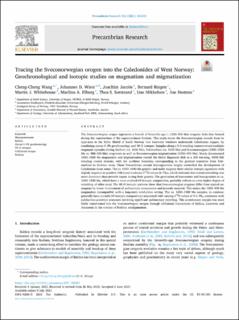| dc.contributor.author | Wang, Cheng-Cheng | |
| dc.contributor.author | Wiest, Johannes | |
| dc.contributor.author | Jacobs, Joachim | |
| dc.contributor.author | Bingen, Bernard | |
| dc.contributor.author | Whitehouse, Martin J. | |
| dc.contributor.author | Elburg, Marlina | |
| dc.contributor.author | Sørstrand, Thea Sætren | |
| dc.contributor.author | Mikkelsen, Lise | |
| dc.contributor.author | Hestnes, Åse | |
| dc.date.accessioned | 2022-03-11T12:04:02Z | |
| dc.date.available | 2022-03-11T12:04:02Z | |
| dc.date.created | 2021-07-29T15:14:36Z | |
| dc.date.issued | 2021 | |
| dc.identifier.issn | 0301-9268 | |
| dc.identifier.uri | https://hdl.handle.net/11250/2984626 | |
| dc.description.abstract | The Sveconorwegian orogen represents a branch of Grenville-age (~1250–950 Ma) orogenic belts that formed during the construction of the supercontinent Rodinia. This study traces the Sveconorwegian records from its type-area in the Baltic Shield of South Norway into basement windows underneath Caledonian nappes, by combining zircon U–Pb geochronology and Hf–O isotopes. Samples along a N-S trending transect reveal multiple magmatic episodes during Gothian (ca. 1650 Ma), Telemarkian (ca. 1500 Ma) and Sveconorwegian (1050–1020 Ma vs. 980–930 Ma) orogenesis as well as Sveconorwegian migmatization (1050–950 Ma). Newly documented 1050–1020 Ma magmatism and migmatization extend the Sirdal Magmatic Belt to a 300 km-long, NNW-SSE trending crustal domain, with the northern boundary corresponding to the gradual transition from Telemarkian to Gothian crust. These Precambrian crustal heterogeneities largely controlled the development of Caledonian shear zones. The ca. 1050–1040 Ma granitic and mafic magmas show similar isotopic signatures with slightly negative or positive εHf(t) and moderate δ18O values (6–7‰), which indicates that crustal reworking was more dominant than juvenile inputs during their genesis. The generation of leucosomes and leucogranites at ca. 1030–1020 Ma, which have a more evolved Hf isotopic composition, probably reflects an even higher degree of remelting of older crust. The Hf–O isotopic patterns show that Sveconorwegian magmas differ from typical arc magmas by lower involvement of sedimentary components and juvenile material. This makes the 1050–930 Ma magmatism incompatible with a long-term subduction setting. The ca. 1650–1500 Ma samples, in contrast, generally have juvenile Hf isotopic compositions associated with varying δ18O values of 4.5–9‰, consistent with subduction-accretion processes involving significant sedimentary recycling. This accretionary margin was most likely transformed into the Sveconorwegian orogen through collisional interactions of Baltica, Laurentia and Amazonia in the context of Rodinia amalgamation. | en_US |
| dc.language.iso | eng | en_US |
| dc.publisher | Elsevier | en_US |
| dc.rights | Attribution-NonCommercial-NoDerivatives 4.0 Internasjonal | * |
| dc.rights.uri | http://creativecommons.org/licenses/by-nc-nd/4.0/deed.no | * |
| dc.title | Tracing the Sveconorwegian orogen into the Caledonides of West Norway: Geochronological and isotopic studies on magmatism and migmatization | en_US |
| dc.type | Journal article | en_US |
| dc.type | Peer reviewed | en_US |
| dc.description.version | publishedVersion | en_US |
| dc.rights.holder | Copyright 2021 The Author(s) | en_US |
| dc.source.articlenumber | 106301 | en_US |
| cristin.ispublished | true | |
| cristin.fulltext | original | |
| cristin.qualitycode | 2 | |
| dc.identifier.doi | 10.1016/j.precamres.2021.106301 | |
| dc.identifier.cristin | 1923051 | |
| dc.source.journal | Precambrian Research | en_US |
| dc.identifier.citation | Precambrian Research. 2021, 362, 106301. | en_US |
| dc.source.volume | 362 | en_US |

